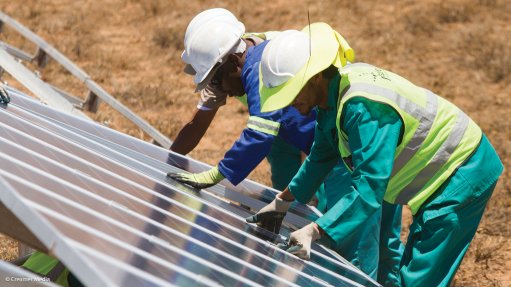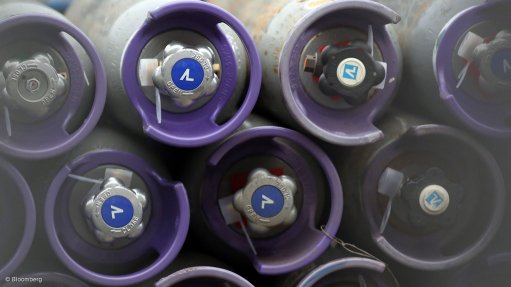Understanding damage tolerance in hybrid bearings
This article has been supplied as a media statement and is not written by Creamer Media. It may be available only for a limited time on this website.
New research by SKF could make hybrid bearings more cost-effective and reliable, paving the way for their use in a wider range of applications.
Hybrid bearings, which combine hardened steel rings with rolling elements made of high-performance ceramic materials, are an increasingly popular option for demanding applications. Bearings of this type can outperform conventional designs where high speeds, high temperatures or poor lubrication conditions are experienced.
Those characteristics have led to their use in jet engines and other critical aerospace equipment. Hybrid bearings also provide high levels of electrical resistance, making them useful in applications, such as electric motors and generators, where stray currents can damage steel bearing surfaces.
Ceramic materials have many characteristics that make them ideal for bearing applications. Modern ceramics such as silicon nitride are hard, light and can be manufactured with an extremely smooth surface finish. Ceramic materials do have disadvantages, however.
Despite continued efforts to improve their toughness, these materials can have issues with damage tolerance in the form of sensitivity to imperfections that may pre-exist in the material or on the surface, which will potentially endanger the integrity of the ceramic rolling elements used in hybrid bearings.
To reduce the occurrence of such problems in service, ceramic bearing components are manufactured under extremely tight quality control, handled with great care during production and assembly operations, and inspected rigorously prior to release. That approach has created products that perform very well in service. But it also drives up cost, limiting the wider adoption of hybrid bearing technology.
One particular challenge for manufacturers is that they haven’t historically had good models for the damage-tolerance of ceramic bearings. Some surface imperfections are so small that they have no effect on the performance or longevity of a bearing, but without knowing exactly where the acceptable limits lie, manufacturers have had to take a conservative approach, rejecting components that might actually have performed perfectly in service.
Now a team from SKF’s Research & Technology Department in the Netherlands is helping to take the guesswork out of ceramic product quality control.
The group has developed a new predictive model of damage-tolerance for ceramic rolling elements used in hybrid bearings, allowing manufacturers to ascertain the precise threshold at which a microscopic imperfection should become a concern.
The team based its research on an extensive series of tests using hybrid bearings or components with imperfections artificially introduced into the surfaces of ceramic rolling elements. The project studied a range of common imperfections.
They included contact marks, such as surface scratches that can be introduced during polishing operations, ring or C cracks, which occur if the component experiences an impact, and surface voids, which can be the result of imperfections in the ceramic materials.
The artificial imperfections were created using various methods, including striking the ceramic ball surface in a controlled manner to create a crack, and laser machining to create a void of a precise size and shape.
These bearings or ceramic components were then tested on a rolling contact fatigue test rig under a wide range of loading and lubrication conditions until failure or suspension. The team repeated its experiments with different types and sizes of imperfection. Some bearings were run to failure, while others were removed from the rig before they failed and studied under the microscope so the team could see how cracks develop and propagate through the material.
The SKF team used its findings to build a new model based on fracture mechanics to predict the damage tolerance of ceramic rolling elements. “We based our work on fracture mechanics, but we added some significant extra elements that account for the unique properties and failure mechanisms of ceramic materials under the relevant operation conditions of hybrid bearings in applications,” explains Junbiao Lai, a senior scientist at SKF.
“In particular, our new model accounts for interactions between the bearing material and the lubricant. Lubricant that enters a crack or void in a bearing becomes pressurised by the bearing loads. That can impart a tensile stress which are generally considered undesirable for lowering the fatigue resistance of a materials.”
Junbiao Lai and his team are confident that their new model accurately reflects the behaviour of hybrid bearings in real operating conditions, and they are now working with SKF manufacturing engineers to apply their findings. “The model allows us to predict when a imperfection is stable, and when it is likely to cause cracks to develop and propagate.”
He explains, “That knowledge could help our manufacturing colleagues to optimise the tolerances they use in production, reducing unnecessary scrap, and it could also help them to refine their manufacturing, assembly and handling procedures.” Ultimately, the work should make high performance hybrid bearings most cost-effective, allowing more applications to benefit from their unique and useful properties.
SKF is a leading global supplier of bearings, seals, mechatronics, lubrication systems, and services which include technical support, maintenance and reliability services, engineering consulting and training.
SKF is represented in more than 130 countries and has around 17,000 distributor locations worldwide. Annual sales in 2017 were SEK 77 938 million and the number of employees was 45 678. www.skf.com
Comments
Press Office
Announcements
What's On
Subscribe to improve your user experience...
Option 1 (equivalent of R125 a month):
Receive a weekly copy of Creamer Media's Engineering News & Mining Weekly magazine
(print copy for those in South Africa and e-magazine for those outside of South Africa)
Receive daily email newsletters
Access to full search results
Access archive of magazine back copies
Access to Projects in Progress
Access to ONE Research Report of your choice in PDF format
Option 2 (equivalent of R375 a month):
All benefits from Option 1
PLUS
Access to Creamer Media's Research Channel Africa for ALL Research Reports, in PDF format, on various industrial and mining sectors
including Electricity; Water; Energy Transition; Hydrogen; Roads, Rail and Ports; Coal; Gold; Platinum; Battery Metals; etc.
Already a subscriber?
Forgotten your password?
Receive weekly copy of Creamer Media's Engineering News & Mining Weekly magazine (print copy for those in South Africa and e-magazine for those outside of South Africa)
➕
Recieve daily email newsletters
➕
Access to full search results
➕
Access archive of magazine back copies
➕
Access to Projects in Progress
➕
Access to ONE Research Report of your choice in PDF format
RESEARCH CHANNEL AFRICA
R4500 (equivalent of R375 a month)
SUBSCRIBEAll benefits from Option 1
➕
Access to Creamer Media's Research Channel Africa for ALL Research Reports on various industrial and mining sectors, in PDF format, including on:
Electricity
➕
Water
➕
Energy Transition
➕
Hydrogen
➕
Roads, Rail and Ports
➕
Coal
➕
Gold
➕
Platinum
➕
Battery Metals
➕
etc.
Receive all benefits from Option 1 or Option 2 delivered to numerous people at your company
➕
Multiple User names and Passwords for simultaneous log-ins
➕
Intranet integration access to all in your organisation





















